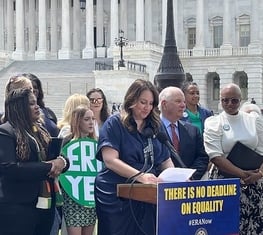Conforti v. Hanlon
Case Summary
New Jersey’s primary election ballot highlights candidates who are endorsed by the local county branches of political parties, a grouping known as the “county line.” Non-endorsed candidates are relegated to a separate area of the ballot which is easy to miss. Best practices for ballot design usually separate candidates by the office for which they are running. The plaintiffs argued this design was confusing and discriminatory against voters and candidates of color. The League and its partners filed an amicus brief in support of the plaintiffs.
New Jersey’s primary election ballot, contrary to best practices endorsed by the United States Election Assistance Commission, does not separate candidates by the office for which they are running. Instead, candidates endorsed by the county parties are placed into a single row or column regardless of office. This arrangement is known as “the county line.” Candidates who did not receive the county party’s endorsement are relegated to separate columns or lines. To be placed on the county line, a candidate must receive permission from the campaign manager of a slate of candidates who file jointly to be listed in one column or row on the ballot. The slate usually consists of the party’s candidates for county freeholder, equivalent to a board of supervisors or county commissioners in other states, or some other candidates for county office. The county line candidates are given the first position on the ballot, meaning they are placed on the left side or top of the ballot, depending on the county.
The remaining candidates are then placed further to the right or bottom of the ballot, as determined by the county clerks. In some cases, candidates have been placed far from other candidates or in hard-to-see areas on the ballot, a situation known as “Ballot Siberia” by local politicos.
The plaintiffs, who were candidates for federal, local, and political party positions, argued that this arrangement, which no other state uses, violated the First and Fourteenth Amendments of the United States Constitution, Section 1983 of the Civil Rights Act, the New Jersey Constitution, and the New Jersey Civil Rights Act.
In response, the defendants moved to dismiss the case, and advanced various arguments, including a lack of standing, failure to state a claim, failure to join indispensable parties, mootness, a lack of ripeness, non-justiciability under the political question doctrine, and sovereign immunity.
The League of Women Voters of New Jersey, together with Salvation and Social Justice, filed an amicus brief supporting the plaintiffs. The brief stated that the ballot design confused voters and disadvantaged non-incumbents by grouping all county line candidates at the top or left. Furthermore, the amici argued that the county line system reduced the likelihood of candidates of color to be elected and exacerbated the lack of diversity in government, as incumbents are disproportionately white and male.
The court rejected the defendants’ assertion of a failure to join indispensable parties, failure to state a claim, ripeness, mootness and non-justiciability, and sovereign immunity. The court ruled that the plaintiffs could proceed with their case and denied the defendant’s motion to dismiss.
The League was represented in this matter by the Campaign Legal Center and the New Jersey Institute for Social Justice.
LWV Timeline
Plaintiffs file their lawsuit
Several candidates for New Jersey’s 2020 Congressional elections filed suit in the United States District Court for the District of New Jersey, arguing the state’s primary ballot design discriminated against candidates not endorsed by the county parties in violation of the U.S. Constitution, New Jersey Constitution, and federal and state civil rights laws.
The League files its amicus brief
The League of Women Voters of New Jersey and Salvation and Social Justice filed an amicus brief supporting the plaintiffs, arguing the state’s ballot design was confusing and discriminatory against voters and candidates of color.
The Court denies the defendants’ Motion to Dismiss
The court denies the defendants’ motion to dismiss, ruling the plaintiffs have standing to sue and that the plaintiffs could proceed with their lawsuit.





